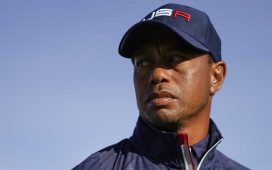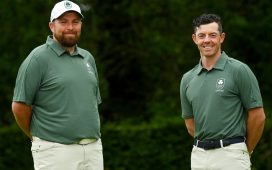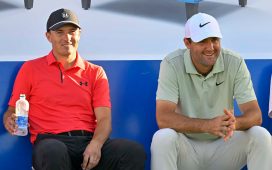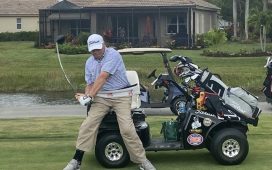They called Sidney Beckwith the living legend. One day, while we were seated in the clubhouse at Green Valley Country Club in Clermont, Florida, one of two courses where Beckwith was a longtime member, the club president approached and said, “You’re interviewing one of the more fabulous characters in the world. Look at him, he goes out and hits the golf ball, plays every day, eats chili. Have you got a tee time, young man?”
“Who are you calling young man, me or him?” he asked with a wink.
Beckwith was age 100 at the time, still wielding a Callaway Epic driver when he teed off at a quarter to eight six days a week to play 18, living alone and driving his Hyundai Elantra in the daytime to his local supermarket. (His first car was a 1929 Ford Coupe.)
“Bob DeStefano named me the Iron Man,” Beckwith said of the head professional emeritus at Gardiner’s Bay Country Club in New York, Beckwith’s summertime hangout. The moniker wasn’t a reference to his proficiency from 150 yards in but rather for his longevity. Beckwith broke his age nearly 1,500 times in his life. “But I tell people I’m all rusted.”
Beckwith passed away peacefully at Brandley Hospice House in Summerfield, Florida, on May 9, but not before living a dream for many golfers – I’d like to live long enough to shoot my age for 18 just once and then I can die in peace. He did it countless times. He was the epitome of the golf saying that “We don’t stop playing the game because we get old; we get old because we stop playing the game.”
“People ask me what my secret is and I tell them it is a secret,” Beckwith joked.
He’d trotted out that line out so many times before that he knew to wait for the laughter to subside. “It has to be luck,” he said. “God’s providence. I’ve had a lot of close shaves.”
Did he ever. When he was 3 years old, a motorcyclist clipped him and dragged him 18 feet before the bike toppled over him and left a rib jutting out for the rest of his days.
In the service, he contracted spinal meningitis and woke up at Letterman General Hospital in San Francisco to a clergyman reading him his last rites.
Another time, sickness saved his life. He got hepatitis from a vaccination and he was in the hospital when his platoon shipped out. They never came back.
Beckwith smoked at least a pack a day until age 27, when he noticed the film on his windows from smoking in his car. He still had two cartons in his closet, but gave them away as Christmas presents and never smoked again. He limited his drinking to an occasional glass of wine.
“I couldn’t handle my booze,” he explained.
He ate healthy – oatmeal with blueberries and walnuts for breakfast, regular helpings of steamed vegetables with fish for dinner, but he splurged Sunday for pancakes and sausage and didn’t like to miss dessert.
Beckwith used to run 10Ks and trained for them by running 5 miles every morning and doing 50 pushups when he finished. One day about 25 years ago, he struggled to catch his breath during his workout. He went to the doctor, who ordered a stress test and sent him to a cardiologist, who told him his main artery to his heart looked like someone had tied a string around it. The doctor couldn’t explain why he hadn’t suffered a massive heart attack. Beckwith had a theory.
“Could it be because I take an aspirin every day?” he wondered.
A cardiologist he played golf with at Gardiner’s Bay had given him that tip long before it was in vogue. He had a stent put in and skirted death again. Like the Energizer Bunny, Beckwith kept going and going. In addition to golf, he played bridge three times a week and loved to dance if he had a partner. He used a stationary bike and a rowing machine in both homes.
“When I get tired, I work out,” he said. “No matter where I go, I see guys much younger than me hobbling along with canes and I think those guys look really old.”
Beckwith was born in New Haven, Connecticut on July 19, 1918, and raised on the eastern end of Long Island in Shelter Island, New York. His grandmother’s cousin was the pro at the nine-hole course there, Dering Harbor Country Club, and he learned the game as a caddie at age 12. His first club was a wooden-shafted mashie and the self-taught golfer became good enough to make the Shelter Island High School team and eventually to be inducted into its Hall of Fame. (He also played on the basketball team.)
Beckwith recalled how lima beans were planted on Dering Harbor’s fairways during World War II. He had been working for four years as a teller at Brooklyn Dime Savings Banks when the war broke out. He resigned to join the Army and defend his country. During his nearly four years in the service, he spent the bulk of his time on the island of Oahu, where he met his wife, Geraldine.
As Beckwith recounted the story, he described a beautiful girl he’d seen on a bus to his commanding officer. It met the description of Geraldine, who was one of the few females working as a civilian in the war department, but with one exception: she always had her hair up. But Beckwith’s superior filed this tidbit away and made an inquiry the next time he saw Geraldine and it turned out she had her hair down on the bus because it was still damp and she was drying it. Beckwith’s commanding officer told her he had someone he’d like her to meet and sent for him. Beckwith was shooting craps in the barracks. He came rushing in wearing fatigues, assuming his commanding officer had a job for him to do.
“I walked in the door and there she was. It was love at first sight,” Beckwith said. “I asked her out and she canceled a date with another officer to do so. She had a diary filled with dates for the next three months. After our first date, she canceled the rest of them and never went out with another guy.”
They were married on March 9, 1946, and raised a son, David, and daughter, Cecilia, back at Shelter Island, where in 1950 the Lion’s Club reopened the course he grew up caddying on as Gardiner’s Bay. He joined in 1955, and hired DeStefano during his stint as club president in 1960-61, and he played endlessly, becoming a low-handicap capable of breaking par. Not even a fresh coat of snow kept Beckwith from playing. His wife painted his golf balls with red nail polish so he could find them.
Beckwith never won the club championship at Gardiner’s Bay, but he did beat noted sportswriter and author John Feinstein in a first-round match in 1975.
“He kicked my ass,” Feinstein recalled. “He beat me on 15. It probably wasn’t even that close.”
Beckwith did manage to win the senior division five times in a row after turning 50, and then just to remind the young whippersnappers three decades his junior who was still boss, he won a sixth senior title 30 years later at age 85.
“I think that’s one of the best things I ever did,” he said, his eyes lighting up as he recalled holing out a 3-wood at the par-4 5th hole for eagle.
For 26 years, he worked for the Suffolk County (N.Y.) Department of Health starting as the assistant inspector and becoming the chief of the bureau of environmental health. He earned a real estate license and dabbled in that world briefly, but quit because it was getting in the way of his golf. When he retired at age 57, he and his wife toured the country on a 10,000-mile trip, which included a jaunt north of the border so he could play Banff in the Canadian Rockies. They were passing through Arizona when he got the bright idea that he’d like to spend his winters playing golf in Florida. He called, rented a place and was driving to a nearby golf course in Howey-in-the-Hills to plunk down his membership fee. On his way, he passed Green Valley and turned around to check it out. The pro invited him to play and he joined there instead. He bought the first spec house overlooking the 12th green with a sunset view over a lake.
Beckwith was married for 53 years, though his wife suffered from Alzheimer’s Disease for the last 10 years of her life. He later had a girlfriend, Helen, who also was 101, and had moved to a nursing home closer to her children in Madison, Wisconsin.
“I’ve got her by a couple of months,” Beckwith said. “She calls me every night and sometimes twice and sings to me.”
Beckwith was 72 when he first broke his age at Green Valley. When he did it for the 100th time at age 85, his golf buddies took him out for a celebratory dinner. It only took three more years to get to 200 rounds at which time his friends at Gardiner’s Bay gave him a plaque that proclaimed his “the guiding light of all golfers.” (The club later renamed its annual Silver Bowl tournament the Beckwith Bowl.)
At age 98, he broke his age more than 100 times. When he surpassed 1,000 rounds, a reporter from the Orlando Sentinel had to see it to believe it. Beckwith saved every scorecard, signed, attested and dated by his fellow competitors. Stacks of them lined the window sill of his bedroom and boxes filled to the gills secured the proof, each numbered, 1,464 in all, and telling a story of his age-defying feats.
Perhaps the best story, though, is one of the times he didn’t break his age. In May 2006, he was invited to compete in the Shoot Your Age Championship against the likes of Arnold Palmer and Gary Player at the Palmer Legends Country Club course at The Villages in Florida. Under the competition format, you played until your score matched your age. Beckwith, 87 at the time, made it to the par-3 17th hole with six shots to spare. He was playing with a marker when he rinsed his tee shot, landed his next shot on the green and took three putts.
“I holed out and I was done, but I beat Gary Player who only made it to the 17thgreen,” Beckwith boasted.
He wanted to break his age 1,500 times, but it wasn’t to be. He played his final round on Thanksgiving Day.
“I’ve had the worst winter you can imagine,” he said.
Beckwith spent December at Advent Hospital in Orlando, where he underwent a hemicolectomy for two cancers in his colon. Five small incisions were made to remove all of the cancerous nodes during a 3-hour surgery. When we met at his home in March on the morning of the first round of the Arnold Palmer Invitational, he had lost 20 pounds and was still in the process of getting his strength back. He fought to the bitter end and never lost his sense of humor or optimism.
When a new doctor asked him his age, he replied, “If you do your job right, I’ll be 102 in July.”








